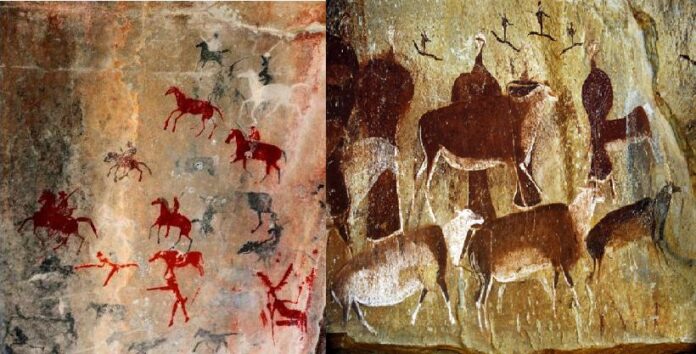Africans and other folks worldwide effectively perceive the Colonial-era rock art craft in South Africa by portraying individuals with colonial-era things and creatures.
These creatures include firearms, ponies, and European-style clothing – the crafting of colonial-era rock art started by South African painters catching European pioneers’ appearance on the scene.
The introduction of the educated methodology utilized the recorded convictions of South African individuals to translate rock arts.
The method, in turn, made the rock art analysts accept that the South African painters should join the homesteaders into their cosmological belief.
As needs be, people perceived the Europeans as threatening powers that could be battled in both the soul world by shamans just as on the scene.
Later exploration has utilized recorded texts, composed by pioneers, voyagers, and ministers, to acquire complete comprehension of these gatherings. This arrangement checks out when perused close by the presence of the art.
Regardless, these texts depict the obstruction of masses exhaustively to European colonization.
By and large, these gatherings were South African, yet they included Kehoe, African ranchers, and surprisingly rampant slaves from the state, just as any combination of these and their relatives. The actual art reflects this blended nature.
Artists craft these artworks are now and again with the almost negligible difference procedure standard for prior South African art.
On different occasions, they are finger-painted, similar to the art of pastoralists and African ranchers.
They can likewise paint the rocks in rough brushwork and sometimes consolidate each of the three methods into a similar picture.
A nearer perusing of verifiable texts likewise clarifies that we can’t check out rock art pictures of individuals with ponies, caps, and firearms or European-style dresses and be sure that they are without doubt portrayals of Europeans.
Numerous Africans embraced these things and creatures during the colonial time frame.
We so frequently see the rock art of individuals with caps and weapons riding ponies, apparently pursuing animals, which seems OK when we consider that blended gatherings of Africans regularly opposed colonial development by attacking the creatures of European pilgrims.
Furthermore, other-common creatures, for example, the downpour creature found before San art, are likewise regularly portrayed in these pictures.
Data from African sources uncovers that the downpour, called after during domesticated animal strikes help the bandits as fog went about as a cover.
And the downpour would wash away the tracks of creatures, making it highly challenging for any followers to follow the resistors.
We likewise see portrayals of different creatures that would be awkward were these pictures the primary portrayals of occasions that occurred.
Primates and ostriches, adored among African gatherings for their powers in burglary and the capacity to anticipate risk, and ostriches for their abilities in issues identifying with escape, likewise show up in rock artboards identifying with stock assaults.
Ceremonial experts inside these blended gatherings called upon the powers of these creatures to aid with the strikes, and the formation of rock art was part of this cycle.
Change in the last 50% of the Nineteenth Century
In the last 50% of the nineteenth century, the stone art of the Northern Sotho went through an emotional change.
The interruption of white pilgrims into the area brought charges, land clearances, and struggle.
A progression of battles to quell Northern Sotho customary pioneers left numerous destitute and penniless.
For now, entire networks escaped to the slope regions. Large numbers of the old inception destinations became shelter settlements.
Another type of rock art created is overwhelmed by portrayals of steam trains, warriors, pilgrims, and weapons.
The pictures catch a group’s misfortune yet fill a more significant need. They made fun of the inconvenient new interlopers and, through this sharp humor, served to beat a portion of the horrible anxieties of the occasions.
The art denotes the beginnings of dissent art in northern South Africa. Also, it represents the customary individuals fighting their entitlement to land and self-assurance.
And finally, the battling obliteration of their conventional constructions and social qualities.


